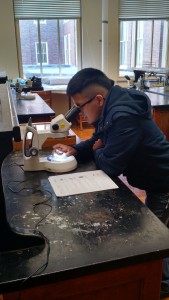In My Classroom – #6 (Getting Students Interested in Science)
Welcome to the KABT new blog segment, “In My Classroom”. This is a segment that will post about every two weeks from a different member. In 250 words or less, share one thing that you are currently doing in your classroom. That’s it.
The idea is that we all do cool stuff in our rooms, and to some people there have been cool things so long that it feels like they are old news. In this segment, if you are tagged all you need to do is share something you’ve done in your classroom in the last two weeks. It must be recent, but that’s it. If you are tagged, you’ve got two weeks to post your entry. Who knows… your supposedly mundane idea, lesson, or lab might be exactly what someone else really needs. Keep it brief, keep it honest about the time window, and share it out! Here we go:
This year I’ve been on a mission to get students interested in science. On the first day of school, I asked my students to draw a picture of what they think a scientist looks like. As you can probably guess, their pictures were predictable and full of stereotypes. Sometimes they were holding a beaker containing a mysterious bubbling liquid, other times they were next to a microscope. But every drawing was of an older white male in a lab coat. Why would my diverse students be into science if they saw it as something for old white dudes? My students obviously did not know many scientists, so I decided to change that.
I reached out to about a dozen biology graduate students at KU and asked if they would be interested in partnering with me for a semester-long project. Our goal is to design and plant a pollinator garden in one of the courtyards at Wyandotte High School. The grad students have been coming to my class every other Friday to work with my students on the garden project. Their lessons have covered a range of topics from Colony Collapse Disorder, to ways of measuring biodiversity. My students have researched native plants that attract pollinators and have made scale drawings  of what they think the garden should look like. We’ve picked a winning design and plan to begin planting the garden early May. Once the garden is established, we plan on creating a database to continually monitor pollinator population data.
of what they think the garden should look like. We’ve picked a winning design and plan to begin planting the garden early May. Once the garden is established, we plan on creating a database to continually monitor pollinator population data.
Overall the experience has been extremely positive. I’ve seen a significant increase in the number of students interested in science careers. My students have taken real ownership of the project, are excited to continue their work, and have formed meaningful relationships with the grad students.
Send some emails. Invite scientists into your classrooms. Help your students dispel stereotypes associated with science and get them involved in projects where they can apply real science skills.

Thanks for sharing, Kelly! I can’t wait to hear how it goes; maybe have a student write about the experience?
Also, who is next? 🙂
Thanks! I’ll update at the end of the semester.
I asked Jesi Rhodes if she’d like to go next. Hopefully we’ll hear about what’s going on in her classroom soon. 🙂